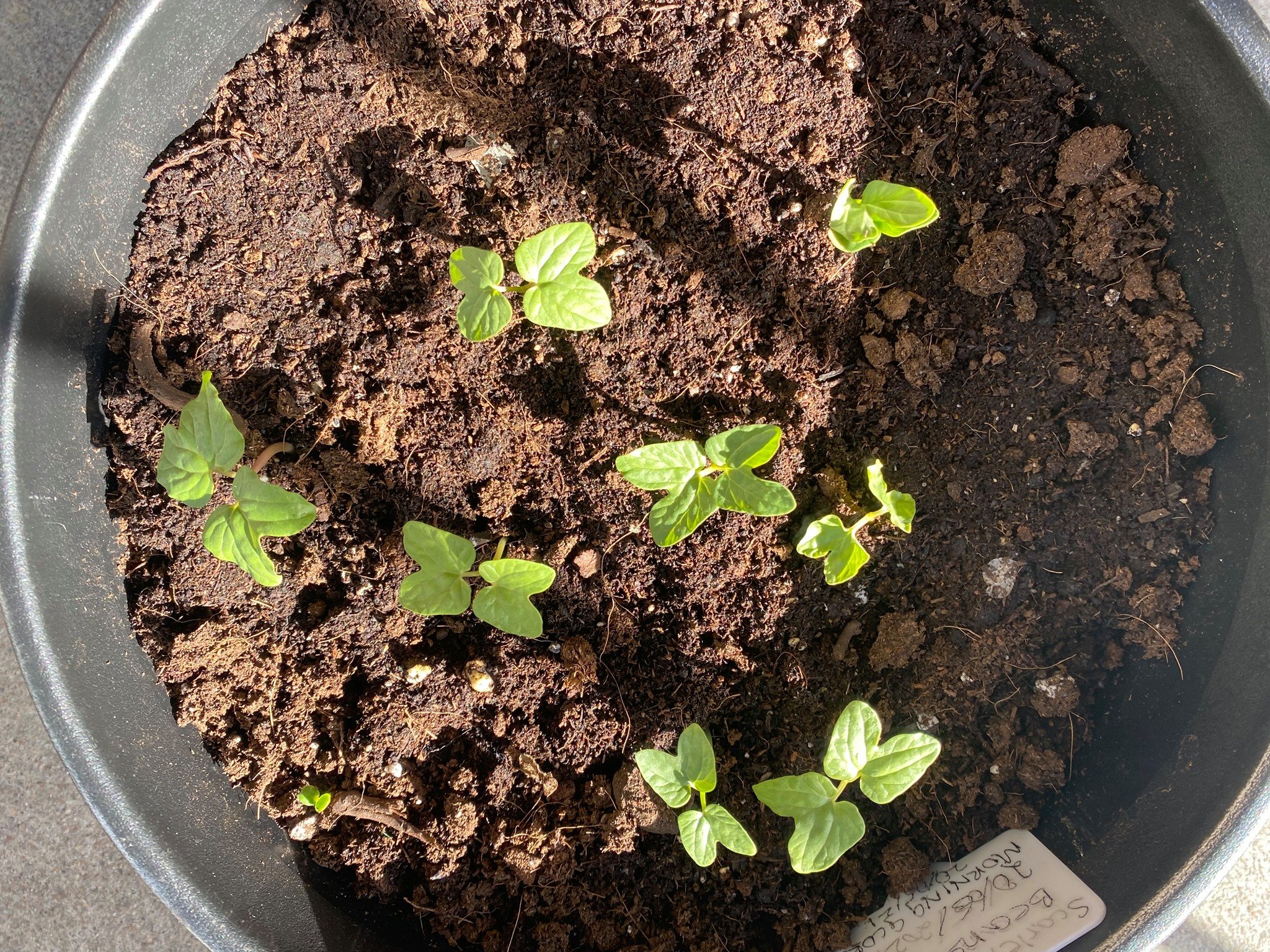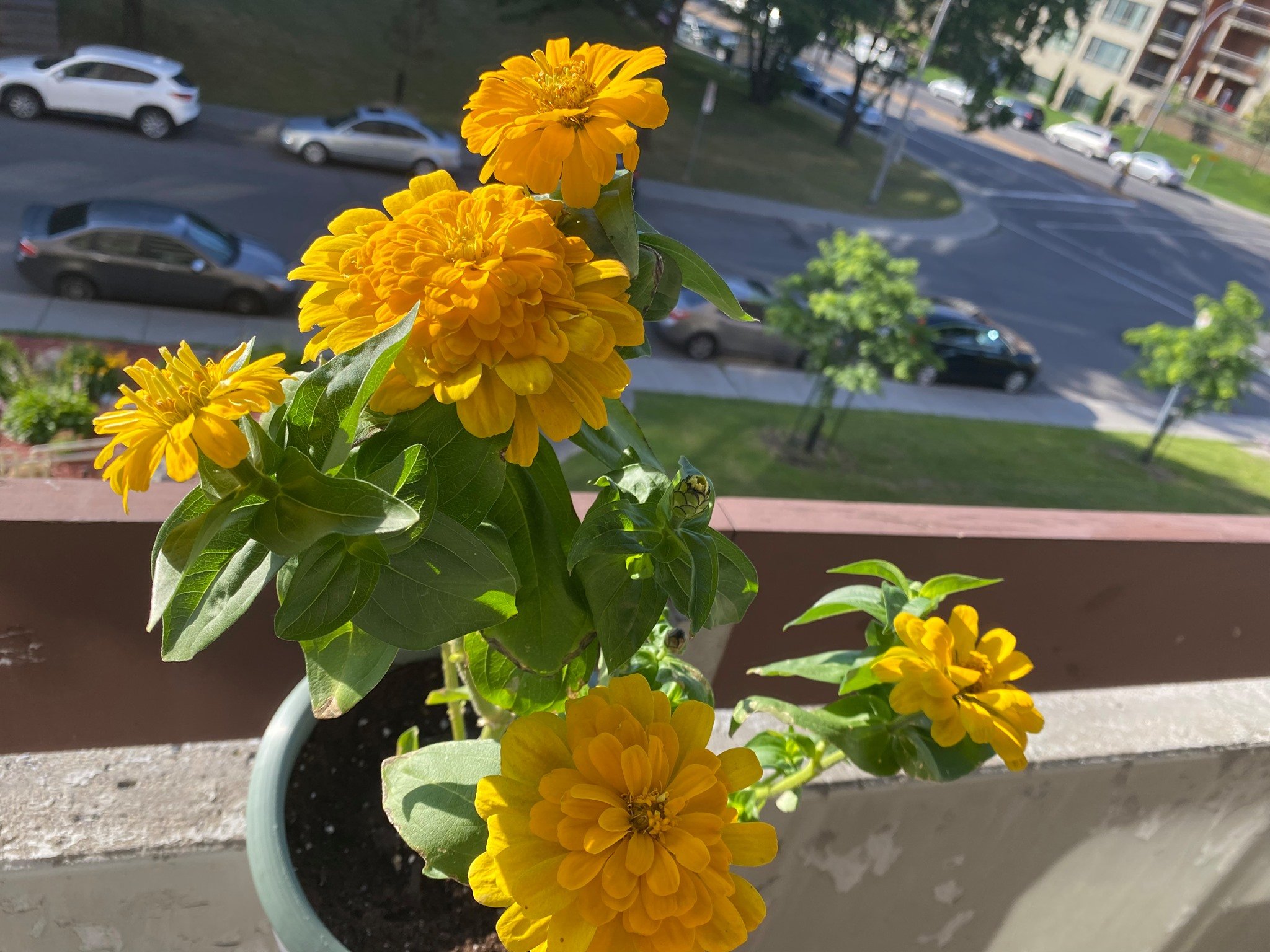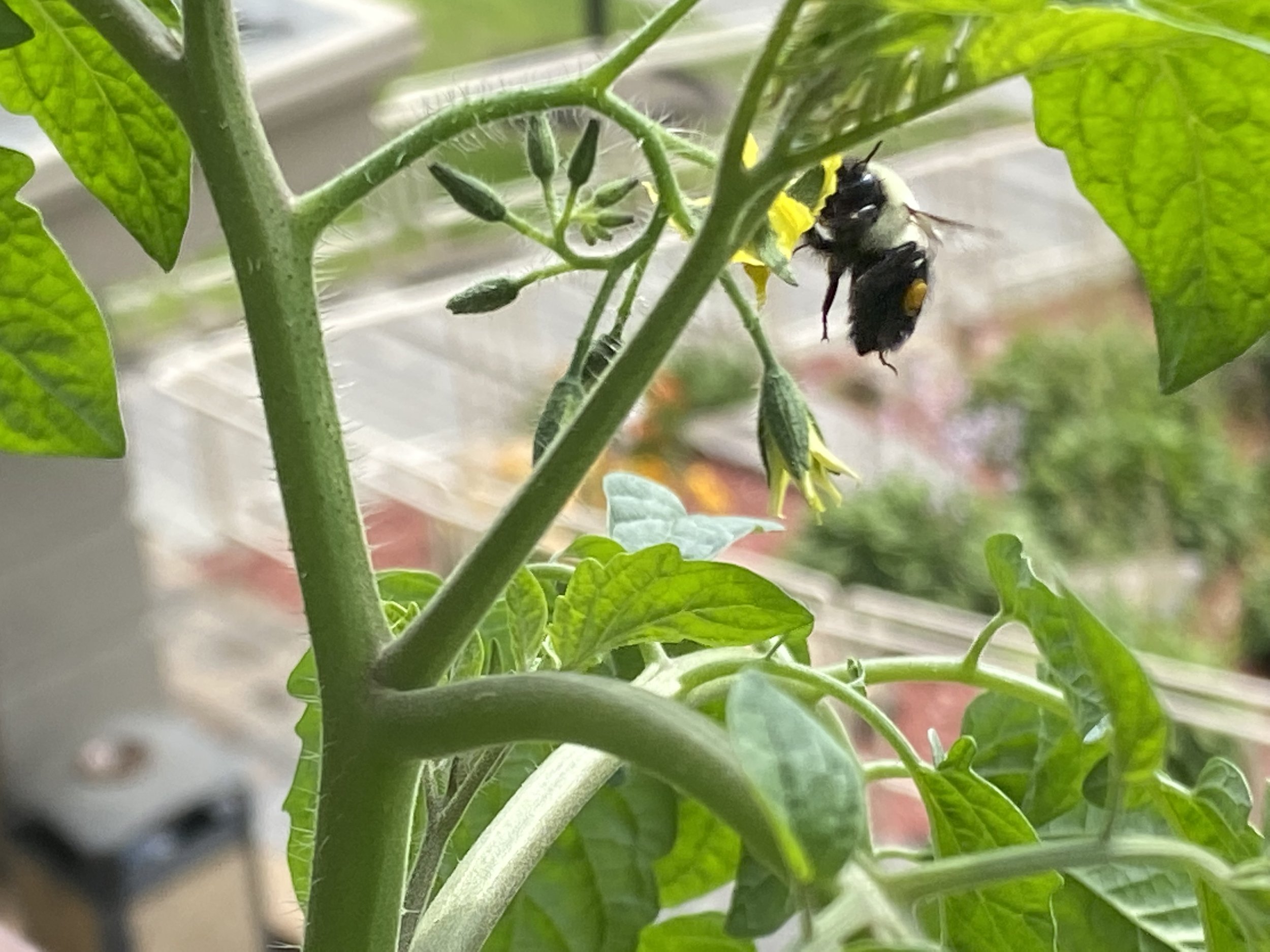Winter Memories of My Summer Garden 2021
Originally published December 28, 2021
I am sitting at my dining table, wrapped up in snug sweaters and warm socks, looking out the window at a world buried in snow. As much as I love the cozy isolation that winter affords I can't help but turn to thoughts of warmer weather. You wouldn't think it to look at it right now, but just a few short months ago my balcony was a little green sanctuary.
For the first time in almost 3 years, this past summer I started gardening again. Now my last attempt at gardening was in Egypt where, by Canadian standards, it is summer or, at least, growing season practically all year long. I didn't try to recreate the same garden I had there as, of course, space and seasonal limitations played a major role. Speaking of which, when I started gardening this year, I dove into it helter-skelter, as I do with most of my personal projects, without first doing my research. The research came afterwards or during the actual planting, which, of course, resulted in many missteps. For one thing, I must have been in an "Egypt garden" frame of mind because I started planting seeds indoors much later than I was supposed to, with nary a care given to Montreal's infamously short growing season and the first and last frost dates.
My first seeds (basil, runner beans, spinach and peppermint) were started indoors as late as mid-May when they should have been started at least mid-April. In my defense, though, we had just come out of a particularly brutal Ramadan month that I just barely managed to get through with my wits about me. Anyways, at least basil and runner beans (especially the latter) grow with almost lightning speed so I was lucky. Unfortunately, while my basil plant was thriving it also developed a disease that turned the stems a dark color from the roots upwards. When I did a quick internet search, I discovered that this is disease is called fusarium wilt and is probably present in the soli itself. The only cure for this was to throw out the entire plant, container and all.
My two basil plants (pre-disease) with the spinach in the middle
Fenugreek microgreens
Scarlet runner beans
Scarlet flowers on my runner beans. They're said to attract hummingbirds.
No luck with hummingbirds, but it did attract this curious little visitor!
While my spinach thrived in the beginning, I realized that it was not the season for it and when I eventually moved it outside, it started bolting (going to seed, giving the spinach leaves a very bitter taste). Another one of the missteps that could have been avoided if only I had read up on when and what to plant during Montreal's short (and usually rain-drenched) summers.
Other plants that I started (outside this time) and perhaps way too late were mini tomatoes, parsley (which didn't sprout), morning glory (a staple in any future garden I will have), sweet peas (sprouted but never flowered as they take a notoriously long time to reach the flowering stage), fenugreek microgreens (my mother usually keeps a container of fenugreek seeds in her pantry as it is commonly used in Middle Eastern cuisine), cosmos flowers (sprouted and flowered in record time and continued flowering right into November), carrots (planted in an inappropriately shallow container and while they sprouted with leaves I ended up harvesting the tiniest carrots in existence), mesclun lettuce, which gave me delicious salad greens for a while but then I got lazy about picking them every 2 weeks and sure enough, they bolted and turned bitter; linaria fairy bouquet which are delicate little multi-colored flowers that look like mini sweet peas and which continued flowering into late fall; and just for the heck of it, I planted a russet potato that was sprouting "eyes" in the same container I had planted my sweet peas in and sure enough, my potato plant grew leaves and foliage and most likely overpowered the sweet peas in terms of soil nutrients and space. When I harvested it, I got many small potatoes that if I had just left for a month or 2 longer would have grown much larger in size.
Tomato greens from planting tomato slices!
Beautiful foliage from simply taking a potato with "eyes" on it and sticking it in soil
Morning glory seeds that literally sprouted in a day (after soaking overnight). It went from this....
...to this in a matter of weeks!
Beautiful colors of my cosmos flowers.
Linaria fairy bouquet
Mesclun lettuce with some beetroots which didn't quite make it
Mini tomatoes at the beginning of the ripening process. Yielded some very sweet tasting tomatoes around early fall!
My carrots planted way too early in the summer and in a shallow pot
...which yielded this....
Understably, Noureen was not impressed....
There were plants that I had bought seedlings of and repotted such as petunias, zinnia, celosia and geraniums, which I have had varying degrees of success with.
With every creative venture, (especially one that I learn by doing, however, haphazardly), I encounter lessons along the way. My second foray into gardening is no different. So here goes:
- Know your environment: space considerations (surface area and orientation), light availability, layout and of course, length of growing season and consequently the first and last frost dates and seasonal planting. My balcony is a typical apartment balcony, a rectangular concrete space, roughly 5 by 21 feet and closed off by another slab of concrete instead of railings for the sunlight to peek though. This was slightly problematic for me as I had to move the plants around constantly out of the shade cast by the concrete "wall" and into the still sunlit areas. Also, I live on the 3 floor so my balcony was shaded by the surrounding structures of neighboring balconies. However, I tracked the sun during the day and in the summer I got an easy 6-7 hours of direct sunlight, albeit weak morning sunlight from around 7am to 2pm or 2:30 pm, (as my balcony is east facing).
- Map out what to plant and where to place them to optimize the space in your garden. For example, I probably should have waited until late summer to early fall to plant lettuce, spinach and carrots as they are typically colder weather crops. Also, while the method of companion planting makes ecological and financial sense (when you're trying to maximize the available containers you have instead of buying more), make sure you know what to plant with what. My idea of planting a russet potato with my sweet peas was most likely the main factor why my sweet peas did not flower as they found themselves competing with the much more vigorous and prolific spud. Also make sure you know what plants are sun-worshippers (such as basil, tomatoes, sweet peas, morning glories, scarlet runner beans) and which plants are more shade-tolerant (mint, spinach and lettuce), and place them accordingly, so you don't spend the entire day moving your pots around trying to chase that last bit of daylight!
- Patience is key! But if you're like me and you jump in, guns blazing and all, and expect immediate results then perhaps plant fast-growing vines. I have a deep love for morning glories. Fun fact: Morning glory seeds are a hallucinogen and used as such by the pharmaceutically brave as they are quite a trip! Anyways, my love of morning glories have nothing to do with their hallucinatory properties but more for their fast growing properties and sentimental value. They literally sprout in a day, and grow like the devil! But also, morning glory was the first flower that bloomed after the birth of my daughter (from a mere sapling) and quickly grew to cover an entire wall of my patio garden in Egypt. During those dark post-partum months, their vivid colors and abundance was like balm to my soul. I even renamed them the "Noureen" flowers in honor of my daughter.
- Be okay with some things not working out. I planted seed-filled tomato slices as an experiment to see if they will bear fruit. They bore foliage and lots of it but no fruit. My wonderfully fragrant basil plant had to be trashed mid-summer as it developed an incurable disease. My spinach and lettuce bolted and my carrots, well, even calling them baby carrots, is too generous. But I was fine with all of that. Next year, I'll do better.
- Don't be afraid to go big- I tend to use small containers, thinking that if my seeds don't sprout then at least I didn't waste a whole lot of soil. And if they do sprout and grow I can eventually transplant them into bigger pots. This is a mistake, however, as I am already setting up myself for failure, at least for certain crops. For example, I should have planted my scarlet runner beans and morning glories in much bigger pots as they grow extensively and their roots need space to expand. But my biggest fail is, of course, my carrots that should have been planted in a deep container (at least 12 inches) from the start. Being root crops, they needed depth and space to develop into their proper size and shape. Thinning out the seedlings (basically plucking out the weak-looking seedlings in order to make space for the stronger ones) is another important factor in ensuring carrots grow properly.
My mini tomatoes were my other faux pas. Don't be fooled by the name, tomatoes (mini or otherwise) should be planted in grower bags and a maximum of 3-4 tomato plants per container. As they grow, their roots take over and then its all about sunlight and space. It is also a good idea to keep "hilling" the plant as tomatoes typically grow new roots (and therefore new tomato crops) every time you cover the stalk up to the small leaves. This is similar to the practice of "hilling" potatoes. While I did eventually get some tomatoes, the harvest was pitiably small.
- Invest in accessories such as tomato cages, supports, netting etc especially for your vines. As my scarlet runner beans and morning glories grew profusely they started bending over and attaching to anything close by. I found myself regularly scouting the building's little communal garden for any sort of fallen branches or sticks that were tall and surdy enough to provide adequate support for the vines. Ideally you should have the supports in place before the vines grow long enough to start twirling around each other. The stalks of my tomato plant, planted in a small container hung off the balcony railing, were so tall that I had to place it on the ground on particularly windy days, for fear that it would snap off.
- Enjoy the process! For that is what a garden is more than anything...It is a process, rather than a final display. I found myself spending many summer afternoons, listening to music on my headphones, puttering around in the balcony, weeding, starting seeds, repotting, and generally getting covered in soil and feeling like I just ran a marathon as my whole body was sore. But it was all worth it because I also spent my weekend mornings with my coffee, journaling, reading and delighting in the results...not just in terms of beautiful flowers, and foliage but also the visitors (of the insect variety) that my garden attracted. Give me a wild garden any day!!
- Every garden is unique and will come with its own set of challenges and rewards. While my patio space in Egypt was problematic in terms of the high walls that allowed sunlight for practically 3-4 hours a day (if even that), I was rewarded with a larger space, the patio being L-shaped and of course, warm weather all year round. My Montreal garden had serious space constraints but more than made up for it with its east-facing orientation which afforded me ample direct sunlight (at the peak of summer, close to 8 hours). I certainly had flashbacks of my Egypt garden, and it would have been great to grow something similar this time around, but back then I hardly grew anything from seed (my garden consisted of mostly fully grown store-bought or donated plants and seedlings). Whereas in my Montreal garden, (with the exception of 5 store-bought plants and seedlings) I grew everything from seed. It was a source of delight and frustration, but in the end, with gardening as with most other creative ventures, it is the long game that counts. So keep playing!































